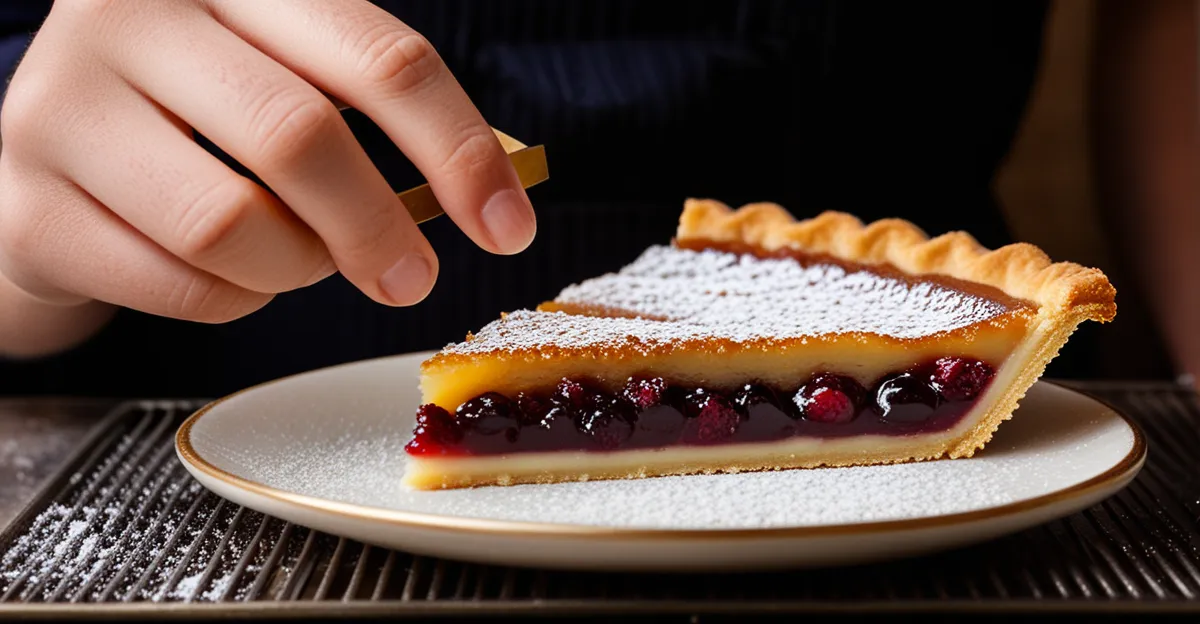Essential Ingredients and Equipment for a Traditional Bakewell Tart
Creating an authentic Bakewell tart requires a careful selection of key ingredients and the right tools. The tart features three main layers: a crisp shortcrust pastry base, a tart raspberry jam filling, and a rich almond frangipane topping. For the pastry, classic ingredients include plain flour, unsalted butter, cold water, and a pinch of salt to ensure perfect texture and flavor. The traditional Bakewell tart jam is best made from fresh raspberries and caster sugar, yielding a vibrant, tangy filling.
For the frangipane, ground almonds, unsalted butter, sugar, and eggs are indispensable, delivering that signature moist, nutty almond flavor. Using high-quality, fresh ingredients enhances authenticity and taste.
This might interest you : What Are the Most Iconic Dishes in British Cuisine?
Regarding traditional Bakewell tart equipment, having a sturdy tart tin with a removable base makes extracting the tart hassle-free. Other essential homemade pastry tools include a rolling pin for even pastry thickness, a mixing bowl, and a pastry cutter or food processor to blend the dough efficiently. Additionally, a metal spoon or spatula is helpful for spreading jam and frangipane evenly.
Sourcing ingredients from reputable suppliers or markets ensures freshness, which is key to replicating the true essence of a Bakewell tart. Using these precise ingredients and appropriate equipment sets the foundation for a wonderfully authentic homemade tart.
Also to see : What Are the Essential Techniques in Traditional UK Cooking?
Preparing the Pastry from Scratch
When making a Bakewell tart pastry, mastering the classic shortcrust pastry is essential. This involves combining plain flour and cold unsalted butter, cutting the butter into the flour until the mixture resembles fine breadcrumbs. Adding iced water gradually binds the dough without overheating it, which keeps the pastry crisp and tender after baking.
To achieve the ideal texture, avoid overworking the dough. Excess kneading develops gluten, risking a tough crust rather than a flaky one. Once formed, refrigerate the dough for at least 30 minutes. This resting period relaxes the gluten and chills the butter, crucial for a homemade tart base that is both firm and flaky.
Rolling out the pastry evenly to about 3-4mm thickness ensures uniform baking without sogginess. Using homemade pastry tools such as a rolling pin with thickness guides can simplify this process. Finally, blind baking the pastry case before adding the filling prevents sogginess caused by the juicy raspberry jam layer, maintaining the traditional Bakewell tart’s crisp base.
These pastry-making basics create the sturdy, buttery foundation necessary for the jam and frangipane toppings, essential for an authentic Bakewell tart experience.
Creating Traditional Raspberry Jam Filling
Making a quality homemade raspberry jam is crucial to achieving a true traditional Bakewell tart flavor. To start, use fresh, ripe raspberries combined with caster sugar, heated gently to allow the sugar to dissolve and the fruit to release its natural juices. Cooking takes approximately 10-15 minutes until the jam reaches a thick consistency, verified by the “wrinkle test” on a chilled plate.
Why is the traditional tart filling so important? The raspberry jam adds a burst of tartness that balances the sweet, nutty frangipane topping and buttery pastry base. Without a well-prepared Bakewell tart jam, the dessert risks becoming overly sweet or flat.
To ensure the recipe’s authenticity, avoid commercial jams that often contain added preservatives or excessive sugar, which can mask the natural raspberry flavor. Instead, making your own homemade raspberry jam allows control over taste, texture, and sweetness, enhancing overall tart quality.
Lastly, applying the jam evenly in a thin layer ensures the pastry remains crisp and supports the frangipane, avoiding sogginess and preserving the classic Bakewell tart structure prized by bakers and enthusiasts alike.
Mixing the Frangipane Topping
The frangipane recipe is central to a traditional Bakewell tart, delivering its creamy, almond-infused layer. The key ingredients include ground almonds, unsalted butter, caster sugar, eggs, and a touch of flour to ensure the right consistency. Begin by beating softened butter and sugar until pale and fluffy, which incorporates air for a light texture.
Next, add eggs one at a time, mixing thoroughly after each to prevent curdling. Fold in the ground almonds and a small amount of flour, gently combining to maintain the frangipane’s characteristic moist but firm texture. This method preserves the rich almond flavour essential to the traditional Bakewell frangipane.
Achieving the perfect almond flavour depends not only on fresh ground almonds but also on careful mixing to avoid overworking the batter, which can lead to a dense result. For an enhanced taste, some bakers add a few drops of almond extract, though this is optional for purists seeking authenticity.
When spreading the frangipane over the jam layer, do so evenly with a spatula to ensure consistent baking and an attractive finish. This approach solidifies the balance of flavors and texture expected from the classic dessert.
Assembling and Baking the Bakewell Tart
Assembling a Bakewell tart follows a precise sequence to preserve the distinct layers of pastry, jam, and frangipane. Begin with the prepared shortcrust pastry tart shell, ensuring it is fully blind baked to prevent sogginess from the jam. Spread a thin, even layer of the Bakewell tart jam, typically the homemade raspberry jam, over the pastry base. This layer acts as a moisture barrier and adds the essential tartness that balances the sweet almond filling.
Next, gently spoon the traditional Bakewell frangipane filling over the jam, smoothing it evenly with a spatula or back of a spoon to secure consistent baking. Avoid overfilling, as the frangipane expands slightly during baking.
Bake the tart at a moderate temperature, around 180°C (350°F), for 35 to 45 minutes. The tart is done when the frangipane topping is golden and slightly firm to the touch. To check doneness, insert a skewer into the frangipane layer; it should come out clean without wet batter.
Using traditional Bakewell tart equipment, such as a tin with a removable base, aids in easy release and presentation. Maintaining consistent oven temperature and not opening the door mid-bake helps ensure even cooking.









